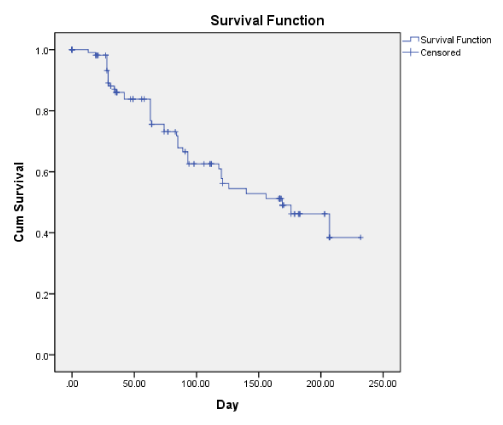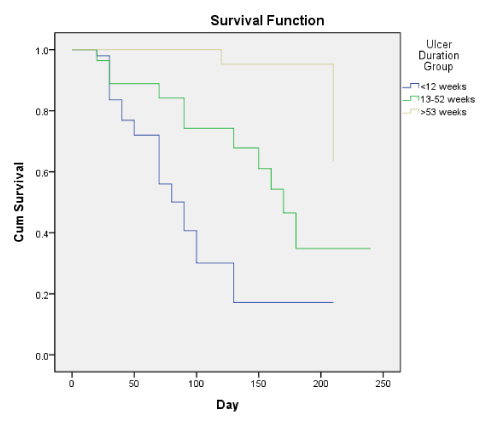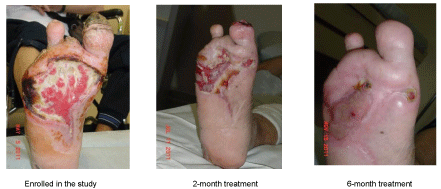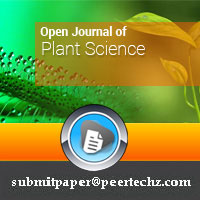Open Journal of Plant Science
Effect of a twin-herb formula for the Treatment of Chronic Non-healing Ulcers: a Clinical Study
Ping-Chung LEUNG1,5*, Tommy Nai-Ming LUK2, Heidi CORCORAN3, Chun -Hay KO1,5, Leung-Kim HUNG4, Lung-Fung TSE4, Hi-shan CHENG4, Winnie W.M. LO1,5, Ellie S.Y. PANG1,5 and King-Fai CHENG1,5
2Dermatology Research Centre, Faculty of Medicine & Therapeutics, CUHK, Hong Kong
3Podiatrist Prince of Wales Hospital, Australia
4Department of Orthopaedics & Traumatology, Prince of Wales Hospital, The Chinese University of Hong Kong, Hong Kong
5State Key Laboratory of Phytochemistry and Plant Resources in West China, Chinese University of Hong Kong, Hong Kong, China
Cite this as
Ping-Chung LEUNG, Nai-Ming LUK, Chun-Hay KO, Leung Kim HUNG, et al. (2017) Effect of a twin-herb formula for the Treatment of Chronic Non-healing Ulcers: a Clinical Study. Open J Plant Sci 2(1): 001-006 DOI: 10.17352/ojps.000005Forty-four patients (27 males and 17 females) with Chronic Non-healing Ulcers that had been refractory to conventional treatment were enrolled in a single arm pre- and post-treatment clinical trial. A twin-herb formula was provided for the treatment for the 6-month study period. All conventional treatment of wound care remained unchanged. Their ulcers were assessed every month. The ulcer sizes greatest length and width was measured at baseline. The target ulcer was assessed at baseline and then every month for 6 months or healed.
The mean age of patients was 66.6 (38.0-93.0) years. The mean surface area of ulcers was 28.0±77.1 cm2 and 14.8±55.0 cm2 at baseline and six months of study respectively. Differences in ulcer area between the initial and final visit were significant (p<0.001). The mean healing time was 149 days (median 167 days). Our results showed that the two-herb recipe (NF3) could reduce the wound size about 50% during 6 months period. 36.7% ulcers were healed. No adverse side effects were founded in our patients during study period.
The twin-herb formula showed promising results in initiating the healing process in chronic non-healing ulcers. It was found to be well tolerated and safe to use. However, further clinical trials should be performed involving a control group to verify these data.
Introduction
When a chronic ulcer fails to heal, the longer it exists, the more difficulty would be expected. It gives much difficulty to both patients and service providers all over the world. Causes of the failure to heal include deformities in the foot, loss of sensation and bacterial infections. Known situations of non-healing ulcers of long durations thus occurred among elderly patients suffering from diabetes and venous stasis. Such patients usually have received surgery including skin grafting yet failed to achieve healing.
We have previously reported on the favorable results of chronic ulcer treatment using a herbal formula of Chinese Medicine among patients suffering from type 2 diabetes and persistent foot ulcers [1,2]. With limited surgical interventions such as limited toe amputations and ulcer debridement, we managed to avoid major amputation in 80% of patients originally scheduled for such intervention unless the ulcer healed.
Basing on the good experience, we have worked out in the laboratory the biological activities of the herbs on the promotion of tissue healing. The herbs mainly worked on the control of inflammation and promotion of granulation formation through stimulation of fibroblast proliferation [3,4].
We therefore planned to offer treatment to a small group of patients who suffered from chronic ulcers for average three years using the same herbal formula. These patients and their attending clinicians lost confidence in surgery or medications and accepted a pessimistic view that the ulcers would never heal. They would therefore accept alternative treatment using herbal extracts.
The aim of this open non-comparative single centre clinical study was to assess the efficacy and safety of a twin-herb formula in the treatment of chronic non-healing ulcers.
Method
This clinical trial was designed as a prospective, non-randomized, single centre, open-label, single arm cohort study conducted between November 2010 and December 2014. The purpose of the study is to assess the progress of ulcer healing among the patients who failed all attempted active treatment in the past years. Duration of ulcer before recruitment in the study and the number of days taken for healing of the wound was recorded.
To assess the inflammatory state of the patients with chronic ulcers, the serum expression of TNF-α and CRP were taken before the start of herbal treatment and at the end of the 6 months’ treatment. The TNF-α data were taken as secondary outcome. During the treatment period, patients received the standard wound care at out-patient clinics. Standard wound care included wound cleansing with saline or water and gentle removal of sloughy or necrotic tissue. Concomitant medications and their indications were also recorded.
Protocol of herbal formula
The study medication consisted of two herbs, viz. Radix Rehmanniae and Radix Astragali. The herbs, in the assigned proportions were boiled together in water in the standard way to produce a broth which was hydrolyzed into standard granules (5 gm per sachet) ready to be made into a drink for consumption.
Follow-up evaluations
Follow-up evaluations were completed on monthly basis. At each clinic visit, the investigator assessed and recorded the followings: examination of the wound, compliance with drug use, and the presence or absence of any adverse events. Study treatment and wound assessment were scheduled to last 6 months or until the ulcer healed. The ulcer was surgically debrided if necessary.
Patients
This was a single centre prospective, descriptive, non-randomised feasibility study conducted in Prince of Wales Hospital Hong Kong over a period of 4 years (from November 2010 to December 2014).
Forty-four patients were recruited, each of whom had non-healing ulcers despite having received conventional therapy for at least 8 weeks. Chronic non healing ulcer has been characterized as one which did not heal over a span of 8 weeks duration. Inclusion and exclusion criteria included: over 18 years of age with chronic cutaneous ulcer at least 8 weeks resulting from causes like venous stasis, leprosy, diabetes or arterial diseases. The main exclusion criteria included pregnancy, spreading infection or cancerous change.
After informed consent, information on the patients’ general and disease-related medical history, and on the duration and a etiology of their ulceration were obtained and recorded. Concomitant medications and their indications were also recorded.
The target wound’s greatest length and width were measured at baseline. The target wound was photographed at baseline and then every month. The target wound was assessed at each visit for local infection and wound condition (improving, stable, or deteriorating). The wound size was calculated by multiplying the length and width. (The greatest length x the greatest width, measured in centimeters).
Aspects of the patients’ existing treatment, such as method of cleansing, dressing-change frequency and type of bandaging/hosiery used, were left unchanged. The only intervention was the application of the twin-herbal formula.
The efficacy of the twin-herb formula was evaluated using the following parameters every four weeks:
1. The number and percentage of patients/ulcers healed by the end of the 6-month study period.
2. Percentage of wound-area reduction
3. Healing rates
Cytokines such as TNF-α, HBA1C and CRP were tested pre- and post-treatment.
The patients were fully informed regarding the composition of the herbal formula and its role in treating ulcers. All the study participants gave written informed consent. The study was approved by the Clinical Research Ethics Committee (CRE-2011.024-T).
Statistical analysis
Evaluation of the efficacy and safety endpoints was descriptive in nature. Healing was assessed by the number and percentage of patients healed by the end of the study. Reduction in wound size was evaluated by percentage change in wound area from baseline and calculated for each assessment (the difference between baseline and post-baseline assessment value divided by the baseline value and the result converted to a percentage).
Data were presented a means ±standard deviations (SD). Efficacy data was performed by using Paired t-test or Mann-Whitney Test to compare the changes between pre- and post-treatment.
The wounds healing time was estimated using the Kaplan-Meier method of survival analysis. This was repeated under the following scenarios:
1. Using all of types of wounds of the patients in the study with standard censoring of observations.
2. Using type of wounds with standard censoring of observations.
3. Cox’s proportional hazards survival analysis with regression covariates was run on all of the wounds to test whether any of the following factors affected wound-healing time: type of wound, size of wound, and duration of wound.
Statistical analyses were performed using SPSS for windows, release 16.0 (SPSS. Inc). P-values <0.05 (2-sided test) were considered statistically significant.
Results
The demographic data, etiologies of ulcers, ulcer area, and duration of ulcer existence and location of the ulcers were shown in (Tables 1-3).
The patients were referred from community nurses. 44 patients with chronic non-healing wounds of different etiologies were recruited.
The study included 44 patients (27 males and 17 females) with a total of 65 ulcers. All wounds had failed to heal with standard therapy. The mean age of patients was 66.6 (38.0-93.0) years old. These wounds averaged 30.8cm2 in size and 143 weeks (2.8 years) in duration (Table 1).
The causes of chronic ulcer included venous stasis (7), diabetes (29), leprosy (2) and other (6) (Table 2).
Most ulcers were located on the ankle (18); next were toes (13) and planta (12); and the last were foot dorsum (6) and heel (6) (Table 3).
Wound size changes duration study period: Table 4 shows the changes in mean surface area of ulcers from visit 1 (28.0±77.1cm2) to visit 7 (14.8±55.3 cm2). From the visit 4, the mean area of ulcer was significantly reduced (p=0.001) (Figure 1). (Table 4) also shows the numbers of healed ulcers during study (6 months).
The number of ulcer was reduced from 65 at the start of study to 29 at the end of study. At 5 months (visit 6), 56.9% of the ulcers were healed. The proportion healed at 6 months (visit 7) was 55.4%.
Table 5 summarises the results of wound size for the 44 patients when segregated into different ulcer duration groups. The wound size reduction in the group wound duration over 53 weeks was fewer that the duration less than 52 weeks.
On completion of the 6 months’ treatment, thirty-six ulcers healed completely. The overall healing rate was 55.4% (36/65). During the course of treatment the average total wound area decreased steadily (Table 4).
When the patients stratified by duration of ulcer before enrollment in the study, we can find that patients with duration of ulcer less than 12 weeks had a significant reduction in ulcer area after 6-month treatment (reduced 87.7%, p<0.001), duration of ulcer 13-52 weeks reduced 59.0% and the duration over 53 weeks only reduced 29.0% (Table 6).
In patients with ulcer duration less than 12 weeks, 71% of ulcers healed within 3 months.
Wound healing time: The overall time taken for healing of the wound was 148.8 days. The shorter the duration of ulcer before enrollment in the study, the shorter the healing time of the wound was taken (Table 7, Figures 1,2).
The overall healing rate was 24.6%. In the group of wound duration less than 12 weeks two patients (28.6%) were complete healed; duration 13-52 weeks 42.9% healed; duration over 53 weeks only 6.7% healed (Table 8).
Analysis of Covariate Effects on Healing Time: Table 9 demonstrated a significant relationships to healing time of duration of wounds (p=0.009). Other covariates (wound type, wound size) did not demonstrate any significant relationships to healing time of all wounds (wound type p=0.862; wound size p=0.682).
Time to healing/partial healing of different duration of Wounds was shown in Figure 2. There were significant differences in healing time among the three ulcer duration groups (p=0.009). That means the duration of ulcer before enrollment in the study could influence the healing time. The longer the duration of ulcer, the longer the healing time (Figure 2).
Case study: 48 year old male patient with a non-healing ulcer: The patient (subject no. DII 17) was a male, aged 48 years old and suffered from diabetic ulcer, which existing already for 43 weeks (301 days), not responding to classic treatment. After 6-month treatment, the ulcer was completely healed (Figure 3).
Inflammatory cytokine changes: There were no significant changes in TNF-α, CRP (C-reactive protein) and HBA1C between pre- and post-treatment (Table 10).
There were 9 patients reported Adverse Events (AEs) such as wound infection, anaemia, congestive heart failure, hypoglycemia, low back pain, hot and red ulcer, chest pain and psychiatric syndrome. However, after assessment, the AEs were unlikely associated with the study herbal formula.
Discussion
Chronic ulcers arising from pathologies of neuropathy and repeated infection fail to heal when the predisposing causes hinder the control of inflammation, block granulation formation and promote infection.
The main objective of the present study was to evaluate the efficacy and safety of a two-herb recipe, as an adjuvant therapy in chronic non-healing ulcers. Our small non-randomized and non-comparative clinical observational trial can give information about the efficacy and tolerance of the treatment with the two-herb recipe.
The results showed that two-herb recipe could reduce the wound size about 50% during 24 weeks period without any significant adverse effect in the studied patient population.
The herbal formulation used in this study contains Radix Rehmanniae and Radix Astragali. Radix Rehmanniae has been shown to greatly facilitate fibroblast proliferation in our laboratory and also in some other studies [3-5]. Astragalus is well known for its immunomodulating effects. The herbal formula works as a supplement to control inflammation and improve wound healing.
For those cases recruited under our present cohort study that yet failed to heal completely at the end of the six months of assigned treatment, the herbal drink was discontinued but topical application of the herbal powder (Radix Rehmanniae) was used so as to acquire more information about the outcome of topical use. Results will be discussed in a separate report.
In order to promote tissue healing, attempts have been given on the use of various growth factors. The results had not been totally satisfactory because of the protein nature of the agents making oral and long-termed administration unfavorable. For chronic ulcers with long years of existence, one expects a slow progress of healing and patience is required for both clinicians and patients. Our herbal formula works as a supplement that initiates a slow control of the adverse mechanisms affecting the ulcer healing [6,7].
The simple combinations of the two herbs have demonstrated good supportive effects on the proliferation of cell cultures. It might be logical, as a next step towards the further development of this ulcer healing agent, to try applying the powder form topically to initiate healing effects. Like all other research on herbal medicine, we have started the bio-guided chemical analysis of the combined extract to identify a sub fraction that might be most efficacious when used either topically or systematically. Our previous study [8] had demonstrated that the clinical benefits of NF3 accompanied by molecular changes in systemic circulation that may explain its wound-promoting and anti-inflammatory effects.
Our study had limitations. First, this was a one-arm study without control, so our results are suggestive rather than conclusive. Second, due to relatively short duration of study we may have missed late beneficial effects of the two-herb recipe and the use of the patients themselves as the treatment controls are limitations of this study. Nevertheless, our results show that this herbal preparation could reduce the wound size without any significant adverse effects.
In conclusion, the two-herb recipe could reduce the wound size significantly in a mean period of 6 months without any adverse side effects. The two-herb recipe may be effective in treating chronic ulcers along with current standard care. However, it must be stressed that good wound care practices including debridement, infection control and offloading play an important role in healing a chronic non-healing ulcer.
This study was supported by the University Grant Committee under the Area of Excellence Scheme (AoE/B-10/ 01), the Institute of Chinese Medicine and State Key Laboratory of Phytochemistry and Plant Resources in West China at The Chinese University of Hong Kong.
- Wong MW, Leung PC, Wong WC (2001) Limb salvage in extensive diabetic foot ulceration—a preliminary clinical study using simple debridement and herbal drinks. Hong Kong Med J 7: 403-407. Link: https://goo.gl/cU1bPZ
- PC Leung, Wong MW, Wong WC (2008) Limb salvage in extensive diabetic foot ulceration: an extended study using a herbal supplement. Hong Kong Med J 14: 29-33. Link: https://goo.gl/tqGRXO
- Lau TW, Sahota DS, Lau CH, Chan CM, Lam FC, et al. (2008) Leung. An in vivo Investigation on the Wound-Healing Effect of Two Medicinal Herbs Using an Animal Model with Foot Ulcer. Eur Surg Res 41: 15–23. Link: https://goo.gl/TGGBrX
- Lau TW, Chan YW, Lau CP, Chan CM, Lau CB, et al. (2007) Investigation of the Effects of Chinese Medicine on Fibroblast Viability: Implications in Wound Healing. Phytother. Res 21: 938–947. Link: https://goo.gl/DJESoM
- Tam JC1, Lau KM, Liu CL, To MH, Kwok HF, et al. (2011) The in vivo and in vitro diabetic wound healing effects of a 2-herb formula and its mechanisms of action. J Ethnopharmacol 134: 831–838. Link: https://goo.gl/wjU51L
- Masoompour SM, Bagheri MH, Borhani Haghighi A, Novitsky YA, Sadeghi B, et al. (2008) Effect of ANGIPARS™, a new herbal drug on diabetic foot ulcer: A phase 2 clinical study. DARU 16: 31-34. Link: https://goo.gl/VT6fuX
- Larijani B, Heshmat R, Bahrami A, Delshad H, Omrani GR, et al. (2008) Effects of intravenous Semelil (ANGIPARSTM) on diabetic foot ulcers healing: A multicenter clinical trial. DARU 16: 35-40. Link: https://goo.gl/2j47pT
- Chun Hay KO, Sui YI, Risa OZAKI, COCHRANE H, CHUNG H, et al. (2014) Healing effect of a two-herb recipe (NF3) on foot ulcers in Chinese patients with diabetes: A randomized double-blind placebo-controlled study. Journal of Diabetes 6: 323–334. Link: https://goo.gl/a6WbjI
Article Alerts
Subscribe to our articles alerts and stay tuned.
 This work is licensed under a Creative Commons Attribution 4.0 International License.
This work is licensed under a Creative Commons Attribution 4.0 International License.




 Save to Mendeley
Save to Mendeley
